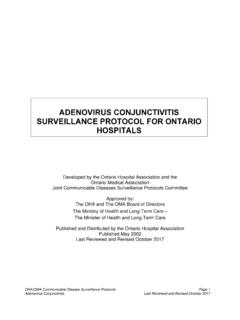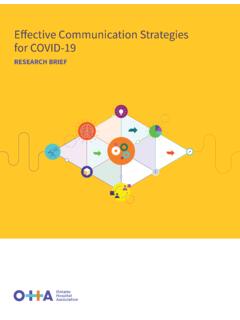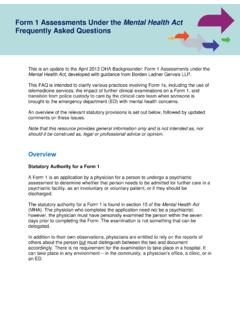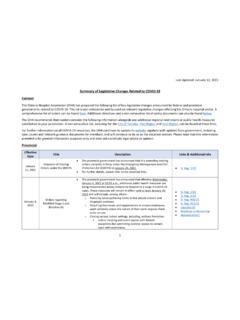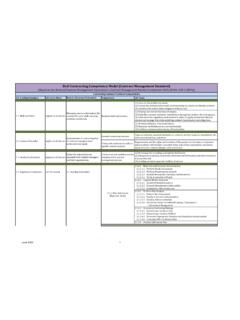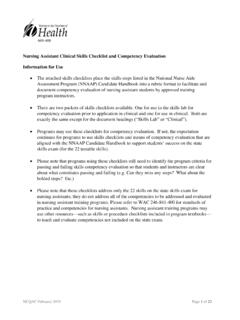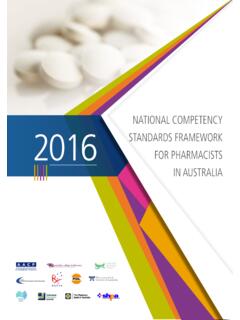Transcription of NCHL Health Leadership Competency Model
1 Transformatio national Center for Healthcare Leadership Health Leadership Competency Model updated, career-spanning Competency Model for Health sector leaders Executive Summary The national Center for Healthcare Leadership (NCHL) is pleased to provide you with a revised and revalidated version of our signature interprofessional Health Leadership Competency Model . This new version represents the work and input of hundreds of healthcare leaders who volunteered their time to participate in interviews, focus groups, and survey responses as part of the revision and validation process. The organizing framework for the Model is displayed in Figure 1. The revised Model is organized around four action domains and three enabling domains, which were derived from the current state-of-the-science in Leadership development and performance research.
2 The action domains contain competencies relevant to the direct work of leaders on the job. These include Execution, Relations, and Transformation, which parallel domains from the Model . Boundary Spanning was added to incorporate recent research in applied settings underscoring the critical importance of leaders' management interdepartmental and interorganizational relationships2. The enabling domains involve core professional knowledge and self-awareness competencies that strengthen the effectiveness of the action domains. These include: Health System Awareness & Business Literacy, Self-Awareness & Self-Development, and Values. These domains represent the leader in the context of their preparation and development to effectively lead in their organization. Collectively the Model includes 28 core competencies, each with accompanying behavioral descriptions at multiple levels of proficiency.
3 The domain structure is designed to provide a user-friendly guide that can help practitioners first set high-level development priorities, and then select specific competencies to focus on to strengthen their capabilities within that domain. If your organization is interested in learning more about Health Leadership Competency Model , please contact FIGURE 1 | Health Leadership Competency Model Boundary Spanning Transformation Action Competency Domains [ 1 ]. Execution Relations Health System Awareness Self-Awareness &. & Business Literacy Self-Development Enabling Competency Values Domains Professional, Organizational, Personal (1) Calhoun, Judith, et al, (2008). Development of an Interprofessional Competency Model for Healthcare Leadership . Journal of Healthcare Management. 53 (6), 375-389. (2) Yukl, Gary. (2012).
4 Effective Leadership Behavior: What We Know and What Questions Need More Attention. Academy of Management Perspectives. 26 (4), 66-85. N at i o n a l Ce nte r fo r H e al t hc are Le ade r s hi p | nc hl. o rg Introduction Competency models provide an important cornerstone for designing strategically aligned learning programs. By specifying a language of performance, they help learners and mentors improve the quality of goal-setting, feedback, and identification of high-value learning activities that can accelerate Leadership development. For more than a decade, NCHL has maintained an interprofessional Leadership Competency Model on behalf of the Health sector to help support Leadership development activities in practice and academic settings of all kinds. In 2017-2018, NCHL embarked on a substantial revision and revalidation of its core Model .
5 With support from faculty and staff of the HSM. Leadership Center at Rush University in Chicago, NCHL completed a four-phase process to ensure relevance of the revised Model to high- performing leaders today, as well as the changing nature of Leadership roles that are anticipated for the decade to come. The first phase of this process involved a systematic scan of published future scenario assessments for the year 2030, from a breadth of US. and international sources from within and outside of healthcare. Trends identified from this scan were then vetted with focus groups of healthcare executives involved in Leadership development in a variety of settings. Next, in-depth behavioral event interviews were conducted with paired-sample leaders representing different organizational and performance levels, and the results were crosswalked with the current NCHL Health Leadership Competency Model Current research on Leadership development was then reviewed to develop an evidence-based domain framework for the revised Model .
6 Finally, the revised Model was distributed via electronic survey to a broader sample of Health leaders to establish content validity and generalizability. As Competency -based education, training, and professional development have evolved and progressed over the years, their use is critical to help respond to: Ever-changing challenges of the 21st century Ongoing changes in practice environments and requirements Development of standards for best practices Interdisciplinary communications and interactions Peer and self-assessments of performance Communication across institutions, departments, service lines, and community-based partnerships Long-term planning for human capital development and management as a key organizational asset Career growth across Health professions and career stages Development of accreditation standards and criteria [2 ] Planning of educational and professional development programs across settings classrooms, workplace, and distance-based formats A Health Leadership Model adds significant value to the field of management and clinical practice, and to faculty.
7 While outstanding Health leaders have a lot in common with and demonstrate the behaviors of the best leaders of the top-performing organizations worldwide, they do so in an industry and environment that call for a higher level of both competence and professional values, given the specific context in which healthcare is provided, where the end consumer is ultimately all people. Health is a mission- and values-driven industry that is extraordinarily complex and, more than other sector, requires building consensus among independent constituencies, many of whom have broad social and political influence and impact. Leaders who have an impact must exercise influence and consensus- and coalition-building competencies at higher levels than their counterparts in other sectors. Finally, Health leaders are especially challenged to create work climates that motivate high-quality, patient-centered care and retain high-demand talent in a very competitive marketplace.
8 The NCHL Health Leadership Competency Model reflects benchmarking against the best available evidence and thought Leadership outside of Health , adapted to them to the unique Health environment. It provides a standard of Leadership excellence, and translates it for improving professional development, organizational performance, Health management education, and, ultimately, the Health of the population. N at i o n a l Ce nte r fo r H e al t hc are Le ade r s hi p | nc hl. o rg About the Health Leadership Competency Model The Health Leadership Competency Model is comprised of seven domains containing four action domains and three enabling domains. The Action Competency Domains describe leaders in the context of doing their work. These include: Execution Relations Transformation Boundary Spanning The Enabling Competency Domains describe preparation and development activities leaders need in order to effectively lead in the context of their preparation and development to effectively lead in their organization.
9 These include: Health System Awareness & Business Literacy Self-Awareness & Self-Development Values Competencies under each domain are shown in Table 1. The definitions for each domain and the related competencies and Competency levels are provided in the following pages. TA B L E 1 | NCHL Competency Domains AC TION DOMAINS ENABLING DOMAINS. Health SYSTEM. BOUNDARY SELF-AWARENESS. EXECUTION RELATIONS TRANSFORMATION VALUES AWARENESS. SPANNING & SELF-DEVELOPMENT. & BUSINESS LITERACY. Community Accountability Collaboration Change Leadership Professional & Financial Skills Self-Awareness Collaboration Social Responsibility Achievement Impact & Influence Information Human Resource Self-Confidence Organizational Orientation Seeking Management Interpersonal Well-Being [ 3 ]. Awareness Analytical Thinking Understanding Innovation Information Relationship & Technology Communication Talent Strategic Network Management Skills 1 Writing Development Orientation Development Communication Team Leadership Skills 2 Speaking & Facilitating Initiative Performance Measurement Process & Quality Improvement Project Management N at i o n a l Ce nte r fo r H e al t hc are Le ade r s hi p | nc hl.
10 O rg TA B L E 2 | NCHL Competency Definitions HEALT H L EA DE RSH I P CO M P E T E N C Y M O DE L 3. 0. AC T I O N CO M P E T E NC Y D O MA I NS. B O U N DA RY S PA NNING. Optimizing relationships between a leader's span of control and the departments, organizations, communities, and/or broader networks within which it operates. Community Collaboration - The ability to align one's own and the organization's priorities with the needs and values of the community, including its cultural and ethnocentric values, and to move Health forward in line with population-based wellness needs and national Health agenda. Organizational Awareness - The ability to understand and learn the formal and informal decision-making structures and power relationships in an organization or industry ( , stakeholders, suppliers). This includes the ability to identify who the real decision makers are and the individuals who can influence them, and to predict how new events will affect individuals and groups within the organization.
